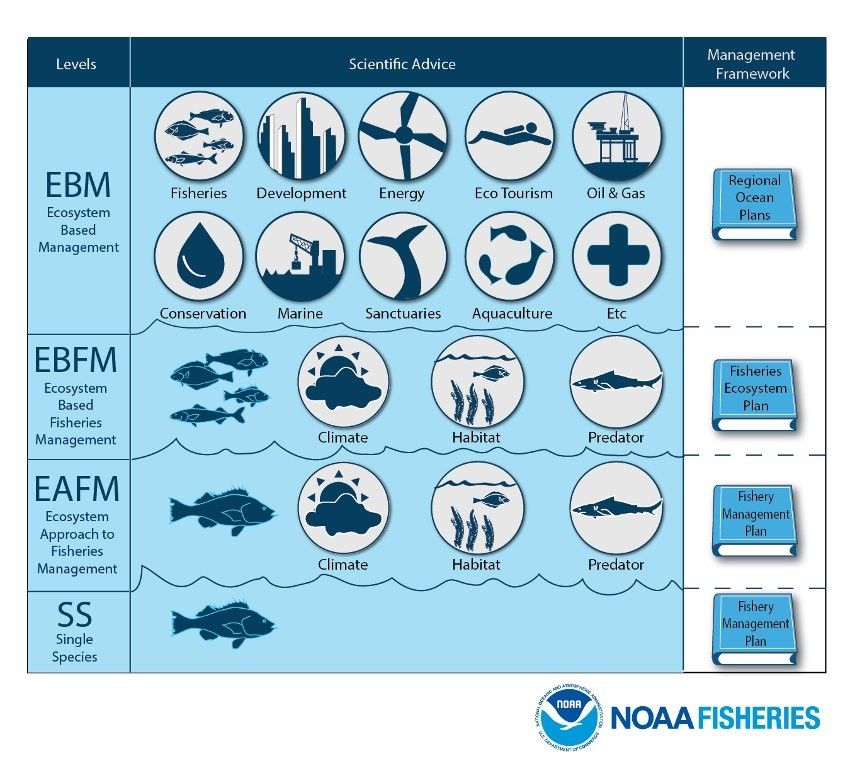In previous blogs we have talked about the importance of implementing appropriate management measures for human activities in our seas to protect species and habitats, whether within a marine protected area (MPA) or as part of wider management, for example the implementation of a marine spatial plan. We often refer to the term ‘Ecosystem-based Approach’ when we are talking about management measures, which is a fundamental consideration in the design and development of management. Scotland has a legal obligation to do this under its various international conservation agreements (e.g. the Convention on Biological Diversity – CBD – which commits the 196 contracting parties, including the UK, to crucial biodiversity targets designed to safeguard life on earth). But what does it actually mean?
You may be surprised – or not – to learn that there’s no absolute definition of ‘Ecosystem-based Approach’. The word “Ecosystem” is defined as “a biological community of interacting organisms and their physical environment”[1]. This gives us a useful starting point: we are talking about something that involves all the living creatures that exist in a particular community and how they function in relation to their surroundings.
The CBD describes the ecosystem-based approach as “…a strategy for the integrated management of land, water and living resources that promotes conservation and sustainable use in an equitable way”[2]. The same section of the CBD further explains that it involves the “…application of appropriate scientific methodologies focused on levels of biological organization, which encompass the essential structure, processes, functions and interactions among organisms and their environment. It recognises that humans, with their cultural diversity, are an integral component of many ecosystems.” This is more of a challenging concept to get our heads around, so let’s break it down:
- “…application of appropriate scientific methodologies…” Management decisions should be based on the best available scientific evidence to make sure it is relevant and appropriate to the features or area being protected. It is generally accepted that in cases where evidence is lacking or confidence in the evidence is low, a ‘precautionary approach’ may be adopted, meaning that the management measures will be more conservative to increase the likelihood that the protection will work;
- “…focused on levels of biological organisation, which encompass the essential structure, processes, functions and interactions among organisms and their environment…” Management should consider all aspects of the ecosystem in relation to what is being protected – for example, management measures designed for the protection of a seal colony must take into account all the things they need to survive and sustain their population. This could include the actual physical area of the colony (on land), the seal’s primary prey species and foraging grounds (at sea), assessing the impacts caused by all pressures that might affect their survival (‘cumulative impacts’) and considering particular seasonal sensitivities (such as breeding or pupping periods);
- “It recognises that humans, with their cultural diversity, are an integral component of many ecosystems.” Humans are as much a part of the ecosystem as any other species. We derive so many benefits from the seas, including our food, energy, health and well-being – these benefits are known as ‘ecosystem services’ and management measures should be designed in a way that these are safeguarded for us and for future generations. For example, healthy living reefs (such as flameshell beds and maerl beds) are known to provide a habitat to juvenile fish and shellfish, and therefore provide an ecosystem service benefit to humans in maintaining seafood stocks. The explicit recognition of humans as part of the ecosystem also means that humans must be part of the decision-making process and all aspects of public interest and opinion must be represented as much as possible.
This infographic by the National Oceanic and Atmospheric Administration (NOAA) gives a helpful illustration of this concept:
The CBD wording for the ecosystem-based approach also refers to land and water, meaning that management in the marine environment should factor in land-based influences as well, such as pollutants entering the sea, and vice versa. That’s a lot of things that marine managers and decision-makers need to consider if they are to properly implement the ecosystem-based approach! And it isn’t easy as there are often a lot of competing interests and compromises may have to be made to try and achieve both conservation objectives and satisfy the needs of stakeholders.
At Scottish Environment LINK we have always advocated strong implementation of the ecosystem-based approach as the Scottish MPA and marine planning processes unfold. Activities at sea cannot be managed in relation to the environment in isolation to the rest, as different pressures have different levels of impact on different species and habitats. To ensure proper protection of species and habitats and address management needs appropriately requires a holistic (all-inclusive) approach in which accounts for all activities and the ecological and social linkages involved.

